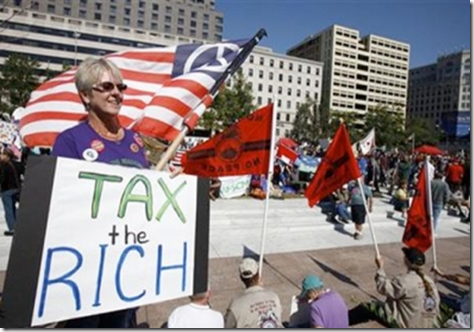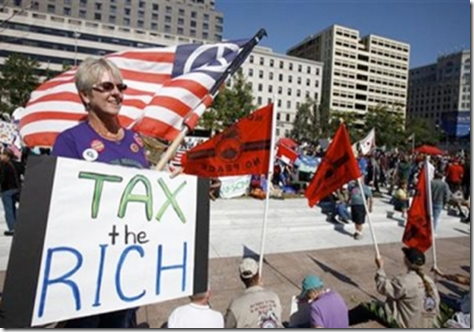Americans must get informed as to what ails the economy. More articles are becoming available, mostly on the Internet, that gives light to the many unnoticed studies that detail the unfairness of America’s tax codes and policies. While the mainstream media gives these studies little coverage at best, it is now the responsibility of citizen journalists and online journalists to use their thousands of spheres of influence to get the information out so that Americans can make the necessary demands on their politicians. The middle class must stop being held hostage by the minority of the ill-informed or the ill-willed.

Every American must read the paper “Changes in Income Inequality Among U.S. Tax Filers between 1991 and 2006: The Role of Wages, Capital Income, and Taxes” by Thomas L. Hungerford, an economist for the Congressional Research Service (CRS). The most important statement in it is
By far, the largest contributor to increasing income inequality (regardless of income inequality measure) was changes in income from capital gains and dividends. Capital gains and dividends were less equally distributed in 1991 than in 2006, though highly unequally distributed in both years. The large increase in the contribution of capital gains and dividends to the Gini coefficient, however, is due to the large increase in the share of after-tax income from capital gains and dividends, and to the increase in the correlation of this income source with after-tax income.
It is not rocket science that income and wealth inequality has exploded since the inception of Reaganomics (voodoo economics according to George HW Bush), or supply-side economics, the actual term. What is absurd is that since all the data is readily available to show the destructive nature of this policy, it is not questioned enough nor is it given the coverage it deserves.
First, a little bit of economics 101 that intelligent politicians choose to forget because they are paid by special interest is in order. If one wealthy person gets an extra million dollars from a tax break or tax cut, it is unlikely that he/she will spend it. It will likely be invested. That investment today would probably not be in anything that will create jobs in America because Americans’ credit, income, & wealth are tapped out. They not going to spend money they do not have.
If 100 poor people get $2000 and 800 middle-class folks get $1000 in tax breaks or tax credits (that’s $1 million), they are likely to spend most of it. They will go to more movies or eat out at a restaurant. They will buy household goods. Those entire activities mean your local community businesses and corporations for that matter will make more money and purchase more inventories, hire more people to handle the increased demand, and pay more taxes. Remember, a dollar circulated creates several dollars of actual income and with that wealth. An invested saved dollar that does not spend locally (in America) is an extraction of wealth from the country for the benefit of the one.
The story gets more interesting. The American tax code has determined that income from invested money in stocks and similar financial instruments, should be taxed at a much lesser rate than income from someone who actually goes out and does work, the garbage man, the engineer, the lawyer, the doctor, the teacher, the policeperson, the fireperson, etc. Since most of the rich earn their income through capital gains, the rise in their stocks, it is a mathematical fact that the growth of their wealth will always be greater than the wage earner. That defines codified systemic wealth and income disparity building policies.
For those who may say that stock prices may fall; the tax code even has an answer for that. Stock losses can be written off from one’s income. The tax code is biased towards the wealthy, the rich. The wealth and income disparity one sees, is much attributed to this. Other policy factors include offshoring/outsourcing of American jobs, a patent system that has gone awry, and a private medical insurance system that saps middle-class American dollars, placing it in the hands of a few wealthy well-connected people.

